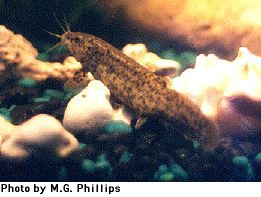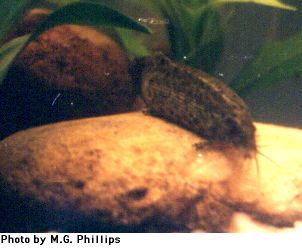
please update your bookmarks!
click banner for the new site and new sections
THIS PAGE IS ACTIVE BUT WILL NOT BE UPDATED, PLEASE GO TO THE MAIN SITE. YOU WILL BE AUTOMATICALLY TAKEN THERE IN 5 SECONDS

CYPRINOIDEI
The Loaches, Flying Foxes and Trunk Fish

|

|

|
Family COBITDAE, ETC



Overview:
- Only a few specimens from these groups of fish are frequently keep by hobbiest. Most aquarists keep them to fulfill the role of scavengers or clean-up fish in a community set up. Not much is known about the biology of the fish belonging to these groups of fish.
-
Most species are elongated and round bodied with an oval sucker-shaped mouth adapted for bottom feeding. This adaptation has allowed the Loaches to survive in fast moving waters, where they are able to hang on to rocks and plants despite the current. Many of the Loaches have spines below the eye area that can stick out and you must be careful when netting or handling them. Some Loaches can live in muddy water that is low in oxygen because they can get air from the atmosphere. Other features of the family are small or minute scales which are hidden under the skin and the presence of of barbels which can range from three to more than four in number. The Weather loach has shown an interesting ability to predict the weather, they show continuous unrest when there is a reduction in barometric pressure and so you can tell hours before an approaching storm front arrives.


Weather loaches.
photos courtesy of Loaches on line
Care:
- The single most important feature you can provide in a tank housing loaches is the availability of hiding places. These can be driftwood, caves, bog roots or even dense thickets of plants. Loaches are shy in nature and need these places to feel secure and without them tend to jumpy and reclusive. Many of these families are nocturnal and will also use their refuges to rest during the day. Most of the Loaches will form territories around their hiding places and defend it from other members of their family. The next important feature of a tank housing these fish is the substrate or gravel, Due to their burrowing habit it should not be sharp or course sand or very fine gravel is best. In nature they feed on insect larvae and worms which they dig out of the substrate, some also graze Algae. In the aquarium they will do fine on flake or frozen food but remember due to their shyness you might want to feed them when the lights are out so the other fish don't get all the food before they can get some.
- Many of the fish in this group are very sensitive to water conditions and cannot tolerate high levels of nitrate. Frequent water changes therefore are needed to maintain their health. All members of these groups prefer a pH that is slightly Acid to slightly Alkaline in the range of 6.5 to 7.5. with a hardness being soft to somewhat hard.

Clown loach
Behavior:
- Varies with the individual species. Some are very territorial and some are quite sociable and live in small schools.
-
Almost all of the Loaches can be kept with fish that tend to inhabit the middle and upper regions of your fish tank. The bottom areas should not contain other fish as territorial conflicts might arise, this is especially true in smaller set ups. One of the most commonly kept fish in this group
labio bicolor has been known to terrorize the entire population of a community tank, while others live in peaceful harmony.
- There is no clear cut or planned breeding technique that can be used on these families. Although they have breed in captivity it has been only accidental. Probably seasonal fluctuations in their environment like, pH, temperature, water levels and salt content provide the stimuli for reproduction.

Banded loach.



Navigation Console
|
|
